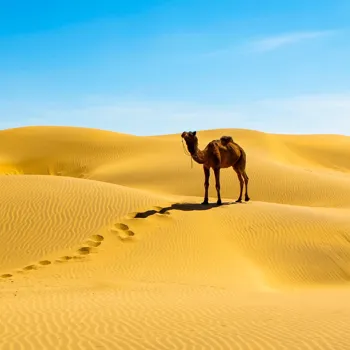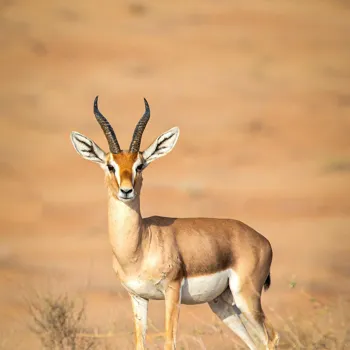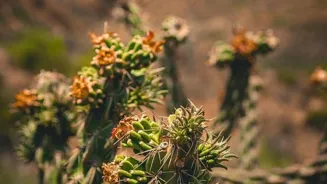Discover the incredible adaptations of India's desert animals in the challenging Thar Desert. Explore their survival strategies in extreme conditions
India, a land of diverse landscapes, boasts not only
lush forests and towering mountains but also expansive deserts. Among these, the Thar Desert, a significant arid region in northwestern India, presents a unique and challenging environment.
The animals that call this desert home have evolved remarkable adaptations to survive the harsh conditions of extreme temperatures, scarce water, and limited vegetation. These creatures exemplify nature's incredible ability to tailor life to even the most unforgiving settings.
The Thar Desert's harsh conditions shape unique animal adaptations
The Thar Desert, also known as the Great Indian Desert, stretches across parts of Rajasthan, Gujarat, Punjab, and Haryana.

Characterized by sandy dunes, rocky outcrops, and thorny scrub vegetation, the desert experiences scorching summers with temperatures soaring above 50 degrees Celsius and cold winters where temperatures can drop to near freezing.
Rainfall is meager and erratic, making water a precious and often scarce resource. The soil is mostly sandy and infertile, supporting only drought-resistant plants.
Despite these challenges, a fascinating array of animals has found ways to thrive in this arid world, showcasing amazing adaptations in behaviour, physiology, and morphology. These adaptations are key to ensure their persistence in this unique ecosystem, demonstrating the delicate balance of life.
Key desert plants support diverse animal life in Thar Desert
Several key plant species have adapted to survive in the arid desert environment. Thorny trees like Khejri and shrubs such as Rohida provide shelter and limited sustenance for the desert animals. Grasses like Sewan provide fodder for herbivores during relatively wetter periods.

These plants possess deep root systems to tap into underground water sources, or they have evolved water-storage mechanisms to withstand prolonged drought. Many also have small or absent leaves to minimize water loss through transpiration.
These plants form the base of the food web, supporting a variety of insects, reptiles, birds, and mammals. Their presence, though sparse, is crucial for the survival of the animal community in the Thar Desert, highlighting the interconnectedness within this ecosystem.
Indian Wild Ass & Chinkara thrive in Thar Desert with unique adaptations
Among the mammals that have mastered survival in the Thar Desert, the Indian Wild Ass (Khur) stands out. Found in the Rann of Kutch, a unique saline desert in Gujarat, the Khur is known for its ability to withstand extreme heat and go without water for extended periods.

They have adapted to graze on sparse vegetation and can travel long distances in search of food and water. Another remarkable desert mammal is the Chinkara or Indian Gazelle.
These graceful antelopes are well-adapted to the arid conditions, possessing efficient water metabolism and the ability to obtain moisture from plants. They are remarkably agile and can escape predators with ease.
Furthermore, several species of desert rodents, such as gerbils and rats, have evolved nocturnal habits, allowing them to avoid the intense daytime heat. They obtain water from seeds and insects and have highly concentrated urine to minimize water loss.
Reptiles and birds thrive in Thar Desert, facing challenges
Reptiles are particularly well-represented in the Thar Desert, with lizards and snakes dominating the landscape. Many desert lizards, such as the Spiny-tailed Lizard, have evolved thick scales to reduce water loss and burrowing habits to escape the heat.
Snakes, like the deadly Saw-scaled Viper, are ambush predators, lying in wait for unsuspecting prey. They are well camouflaged against the sandy terrain. Among birds, the Great Indian Bustard, a critically endangered species, is perhaps the most iconic desert bird.
These large, ground-dwelling birds have adapted to survive in arid grasslands and scrubby areas. They are omnivorous, feeding on insects, seeds, and small vertebrates. Their survival is threatened by habitat loss and hunting. Other bird species include larks, eagles, and falcons.
Insects adapt to Thar Desert, crucial for ecosystem balance
Insects and other invertebrates also play a vital role in the Thar Desert ecosystem. Beetles, ants, and termites have developed various strategies to cope with the desert's harsh conditions.
Some beetles have waxy coatings on their bodies to reduce water loss, while others are active only during the cooler hours of the night. Ants, like termites, live in underground colonies, which help them maintain a stable microclimate.
These insects serve as an important food source for many desert animals and contribute to nutrient cycling in the soil. Scorpions, spiders, and other arachnids are also common in the desert, adapted to hunt in the dark.
The intricate web of life in the Thar Desert highlights the importance of every species, regardless of size or perceived importance.












